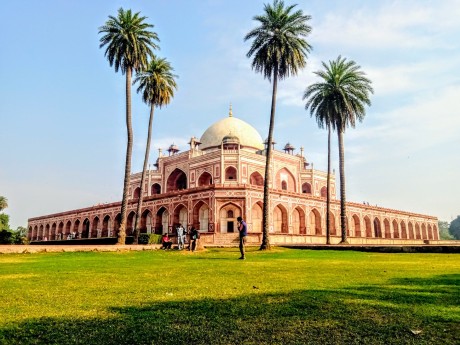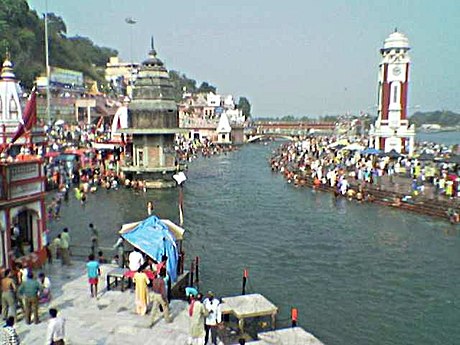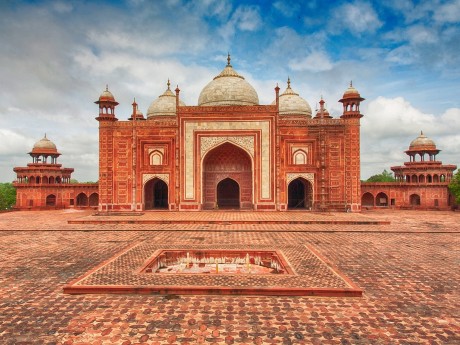India: New Delhi & Haridwar
Embark on an enchanting journey through New Delhi and Haridwar, two of India's most vibrant and spiritually enriching destinations. Begin in New Delhi, the nation's bustling capital, where ancient history and modernity coexist. Explore iconic landmarks like the Red Fort, Qutub Minar, and India Gate, while immersing yourself in the cultural tapestry at Chandni Chowk and Connaught Place. Savor the city's diverse culinary delights and witness the grandeur of the Lotus Temple and Akshardham.
Read more
Embark on an enchanting journey through New Delhi and Haridwar, two of India's most vibrant and spiritually enriching destinations. Begin in New Delhi, the nation's bustling capital, where ancient history and modernity coexist. Explore iconic landmarks like the Red Fort, Qutub Minar, and India Gate, while immersing yourself in the cultural tapestry at Chandni Chowk and Connaught Place. Savor the city's diverse culinary delights and witness the grandeur of the Lotus Temple and Akshardham. Then, proceed to Haridwar, a sacred city on the banks of the holy Ganges River. Experience spiritual rejuvenation as you participate in the mesmerizing Ganga Aarti at Har Ki Pauri, visit revered temples like Mansa Devi and Chandi Devi, and stroll through the bustling local markets. The serene ghats, yoga retreats, and ashrams offer a tranquil contrast to New Delhi's vibrant energy, making this journey a perfect blend of cultural exploration and spiritual awakening. Waterviews strives to offer accommodation options within walking distance of water and/or in an area of touristic interest. Our prices include taxes (but excludes local tourist taxes). Customize your trip to your personal preferences with optional activities (hit the “Add Activities’’) or change hotels, etc. Contact us for customization at no extra cost at: Service@waterviewstravel.com
Destinations
- Delhi
- Haridwar
Itinerary
Delhi

Delhi is India’s modern capital, and it is here that you can witness the merging of old and new. The city’s vibrant, colourful and sometimes chaotic streets offer an insight into modern day India as well as into its rich history, with evocative street bazaars, ancient monuments and colonial-era buildings on every corner. Made up of seven ancient cities, Delhi’s past spans centuries, and as a result the city is home to a plethora of temples, tombs and mosques that will transport you back in time.
Read more
Delhi is India’s modern capital, and it is here that you can witness the merging of old and new. The city’s vibrant, colourful and sometimes chaotic streets offer an insight into modern day India as well as into its rich history, with evocative street bazaars, ancient monuments and colonial-era buildings on every corner. Made up of seven ancient cities, Delhi’s past spans centuries, and as a result the city is home to a plethora of temples, tombs and mosques that will transport you back in time.
Additional Information
Travellers with little experience of visiting developing megacities will find Delhi to be chaotic, crowded and for much of the year, polluted. During the late spring and early summer months, the city is scorchingly hot. Dig a little deeper however and you will get a glimpse of order beneath the chaos as well as India's traditional and modern cultural richness flourishing side by side. First-time visitors feeling the culture shock are recommended to not compound that by visiting during adverse weather conditions, and get a decent hotel room so you can stay in comfort between your sightseeing trips.
History
With evidence of continuous settlement dating back to the 6th century BC, Delhi is one of the oldest inhabited cities in the world. Thought to have been built and destroyed eleven times, evidence of at least eight distinct settlements can still be seen in Delhi. The most well-preserved historic sites are from the periods of Muslim and British rule, between 1193 and the 1947.
The legendary city of Indraprastha from the epic Mahabharata is said to have been situated where Delhi now lies, but no remains of it have been found.
From the 10th to 14th century, the city was centred in what is now South Delhi: - Built in the 9th-10th century on what is now the far southern outskirts of Delhi. A large water reservoir can be seen, well preserved.(or Rai Pithora) – Founded in perhaps the 11th century as a city named "Lalkot" under Hindu rule, in the current Mehrauli area. In around 1180, Hindu ruler Prithviraj Chauhan expanded this city and renamed it Qila Rai Pithora. Some of the ruins of the fort ramparts from this period are still visible around Qutab Minar and Mehrauli. – Shortly afterwards, in 1192, Muslim leader Muhammad Ghori defeated Prithviraj Chauhan in battle. Ghori left his slave Qutub-ud-din Aibak as his viceroy, who in turn captured Delhi the subsequent year. After Ghori's death in 1206, Qutub-ud-din proclaimed himself the ruler of Delhi and founded what is known as the Slave Dynasty of the Delhi Sultanate. Qutub-ud-din contributed significantly in terms of architecture by building Mehrauli. His most prominent contribution is the starting of Qutub Minar (which was finally completed in 1220). The tombs and other buildings near the Qutub Minar also date to this period. - The Slave Dynasty was followed by the Khilji (or Khalji) dynasty. In 1303 they established Siri, first as a military camp to protect against possible Mongol invasion, and later as a fortified city. Nowadays Hauz Khas complex (north of Mehrauli) contains ruins of Siri Fort, a madrassa, and other buildings from the period. - After the Khiljis there was chaos until Ghiyasuddin Tughlaq (a Turk governor) invaded Delhi in the 1320s, started the Tughlaq dynasty, and founded a new capital Tughlakabad, in South East Delhi. His son Muhammad Bin Tughlaq created another city called Jahapanah in the area between Siri and Qila Rai Pithora, uniting them into one city. Tughlakabad continued, however, to be the main capital city.
Starting in the 14th century, new areas were built further north, near the current city center:(or Kotla Firoze Shah) - built by Muhammad Bin Tughlaq's son, Firoze, in 1354. There still are some ruins which are visible around the Feroz Shah cricket stadium in Central Delhi, near the river. The city was an enclosed a large area, and contained many palaces, mosques, pillared halls, and a multi-floored water reservoir. Firoze also erected a 1500-year-old Ashokan Pillar (previously erected in Meerut by Samrat Ashok) on top of the palace. Firoze was buried inside a lofty tomb in Hauz Khas. After his death, the sultanate became unstable and weak, and Delhi was conquered and sacked by Tamerlane. The Sayyid and Lodhi dynasties who ruled Delhi after the Tughlaqs did less building, and the only relevant architecture visible from this period are the tombs at Lodhi Gardens. The last of the Lodhis was defeated by Babur, who then proceeded to establish the Mughal Empire in 1526. - In 1533, Babur's son Humayun built the new city of Dinpanah, near the river south of Firozabad. In 1540 Humayun was defeated by Sher Shah Suri and forced to withdraw from Delhi. Sher Shah Suri established the new city Shergarh on the ruins of Dinpanah. Shergarh is what you see at Purana Qila today, near the Delhi zoo. Humayun later reconquered Delhi and returned to power. He then completed the construction and proceeded to rule from Shergarh. - the following emperors moved away from Delhi and made Agra their capital. Shahjahan (Humayun's great-grandson) returned to Delhi and established Shahjahanabad (modern Old Delhi), including the Jama Masjid and the Red Fort. Much of the city wall, and three of its six gates, still exist today. - New Delhi was established in 1911 after the British decided to move India's capital from Kolkata. It is a planned city, designed by architect Sir Edwin Lutyens.
Demographics
Not all descendants of the builders of Delhi's many Muslim monuments live in Delhi. Many of them migrated to Pakistan during the Partition, with the community in Old Delhi that is keeping old courtly traditions alive smaller than it once was. The city is rich in monuments, including 174 ASI protected monuments.
The population of Delhi is a heterogeneous mix of people originally belonging to different parts of North India and beyond. Among the prominent North Indian communities are the Punjabis. Delhi also has a prominent South Indian Community, primarily in neighborhoods like Karol Bagh, RK Puram, Mayur Vihar and Munirka. A Bengali settlement, the Chittaranjan Park in south Delhi, is the Mini Calcutta of Delhi. Quality education also draws students from different states, making up one of the most diverse student populations in the country.
Orientation
Like the rest of the Gangetic Plains, Delhi is as flat as a pancake. The only geographical features of any significance are the river Yamuna, which flows down the eastern side of the city, and the Aravalli Hills which form a wide but low arc across the west. On the west bank is the crowded and congested Old (Central) Delhi and, to the southwest, the broad, tree-lined avenues of New Delhi, built by the British to rule their empire. The rest is an endless low-rise sprawl of suburbia and slums, with southern Delhi generally wealthier.
© Sourced from Wikivoyage
Haridwar

Haridwar (हरिद्वार), also spelled Hardwar, is a city in the state of Uttarakhand, India.
Read more
Haridwar (हरिद्वार), also spelled Hardwar, is a city in the state of Uttarakhand, India.
Additional Information
Haridwar, literally translated as the Gateway to God, is one of the Hindu holy places in India and a centre of Hindu religion and mysticism for centuries. Located on the banks of the River Ganges (Ganga), at the point where the Ganges descends from the hills to the North Indian plains, Haridwar attracts a large number of Hindu pilgrims from all over the world.
Festivals
Haridwar is the site of many religious festivals. Most notably, once every twelve years it is the venue for the Kumbh Mela, the world's largest festival, which drew a record 70 million in 2003. (The festival rotates between Haridwar and Allahabad, Ujjain and Nashik.) The Ardh Mela, or "half mela", is held every six years. The last Maha Kumbh Mela was in 2010, and the last Ardh Mela was in 2016.
Other yearly festivals include: Baisakhi, It is held in the month of April and devotees from Jharkhand, Bihar, Gujarat, Uttar Pradesh, Delhi and Haryana converge here to celebrate the auspicious festival Baisakhi. Kanwar Mela, July. The largest yearly festival, drawing up to 300,000 visitors. Kartik Purnima, held 15 days after Diwali on the first night of the full moon in November. Somwati Amavasya, July. Almost as large as the Kanwar Mela.
While the festivals are colorful and fascinating, they also strain the town's limited infrastructure to the breaking point and sometimes beyond. Book rooms and tickets well in advance, and avoid travel by road as the traffic jams can be horrendous.
© Sourced from Wikivoyage





